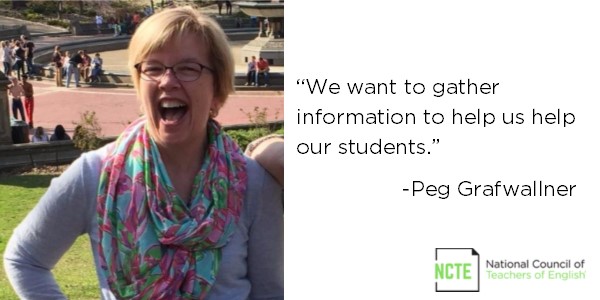This post is written by Peg Grafwallner.
Of course it’s not unusual to hear groans when the teacher mentions a test is in the near future, or worse yet, whimpers when a pop quiz is announced.
But instead of using the traditional and frightening language of test or quiz, how about if we change that language to reflect what we really want—an awareness of our students’ understanding or comprehension of a text, piece of art, or refrain of music. We don’t want this situation to be a “gotcha” like so many tests are; instead, we want this to be an opportunity to learn how we can assist, support, or revise our students’ learning or thinking.
We want to gather information to help us help our students.
When I taught my reading skills class, there were two specific things I did during test-taking situations. First, I changed the language. The words test and quiz were no longer allowed. We considered them to be words associated with evaluation. Oftentimes when taking a test, there had been no recourse or do-over. The grade was the grade—it was all but etched in stone. If the grade was poor, the student failed and the entire experience was considered a failure. However, I explained to the students that a Check-Up was a way for me to learn more about their understanding of the material we had covered.
Giving students a Check-Up helped me to determine if students could synthesize their learning to me or someone else. If not, what could I do to help them learn the material, and what could the students do differently to be successful on the next Check-Up? Truthfully, the change of language alleviated most of their concern and fear. In addition, since it was a Check-Up, feedback was expected and anticipated. Students were eager to learn how they could better prepare for the next Check-Up to demonstrate their understanding.
Second, I understood that for some students, test anxiety is real, and their concern is palpable. As a result, it was important to demonstrate empathy and to show students that I understood their trepidation. Therefore, I allowed my students to pick the day of their Check-Up. In that way, they had control over their learning. What day did they want to demonstrate their understanding? I wanted to give students power in choosing the Check-Up day because they knew their personal/academic calendar better than I did.
If the majority of students had an extracurricular scheduled on a Tuesday, then perhaps we scheduled the Check-Up on Wednesday. Or, if the majority of students knew ahead of time that they were scheduled to have an English test on Thursday, then we scheduled our Check-Up for Tuesday. They were able to choose a day that worked best for them. This control gave them confidence in their learning and empowerment in their knowledge.
The next time you’re preparing students to demonstrate their knowledge, consider changing your routine. Giving students the opportunity to schedule the Check-Up and eliminating pessimistic language could help create a more community-centered classroom and a less anxiety-ridden student. Your students will appreciate your sensitivity and compassion toward their personal and academic lives, and you will appreciate a more energized and self-confident classroom.
Peg Grafwallner is an Instructional Coach and Reading Specialist at a large urban high school. Peg draws on her nearly 24 years of experience and expertise to focus on engagement, motivation and interventions to create student opportunities of learning and inquiry. Contact Peg at www.peggrafwallner.com or at twitter @peggrafwallner.

